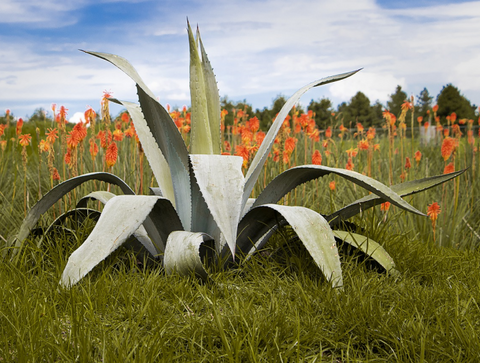WINE AND MEZCAL – NOT THAT DIFFERENT AFTER ALL

When you start learning about wine, the first thing you find out is that the more you learn, the more you realise there is for you to learn. You come in with the absolute basics: you know about white wine and red, and sparkling versus still. Then you discover how tannins work, and you start learning about the different varieties of grape, and how they are combined. You understand how the same grape variety can have a completely different effect, based on the climate it was grown in. What started off as a simple “Wine? Yeah, I like red!” is now a vast universe of discovery.
Wine has been generally acknowledged as a complicated field. Wine experts abound and you can study and become qualified as a sommelier. The world appreciates the variety and nuance of wines and the grapes that go into them – and we think it’s about time the same thing happened with mezcal.

Mezcal is made from agave, in specifically-designated areas of Mexico (find out more about mezcal in our History of Mezcal blog). Just as wines can be made from either a single grape or a blend, the same applies to mezcal. While many mezcals are produced from a single variety of maguey (agave), others are assemblages – or “ensambles” – made up by selecting a careful balance of different varieties, then roasting the different maguey piñas together before the fermentation process.
But what differentiates one agave variety from the next? Quite a lot, as it turns out.
MEZCAL BY AGAVE VARIETAL
Different agave varieties lead to stunningly different mezcals, and each variety has its own distinct character. Here’s a quick introduction to some of them.
1. Espadín
This is the most common agave used in mezcal production, and is grown all over Mexico. Of the species Agave Angustifolia, Espadin is a narrow-leaved, not particularly fibrous agave, which is used as the base for somewhere between 80-90% of all mezcals. It takes about 12-14 years to grow to maturity, and produces a flavour palate fairly similar to that of a tequila – towhich is normal, as the blue agave used to make tequila is another variety of the Agave Angustifolia species. Mildly sweet, with light herbal and citrus notes, Espadin was for a long time the unrivalled champion of mezcal agaves. In recent years, other varieties have started to grow in popularity, which brings us to…
2. Tobala
Known as “the king of agaves”, Tobala was the first non-Espadin maguey to have success in the United States. This incredibly rare agave can’t reproduce asexually, and relies on birds and bats to do the work for it. Tobala is of the Agave Potatorum species, and has wide, spade-shaped leaves. Its rarity, plus the fact that its hearts are fairly low-yielding, makes Tobala something of a luxury. Its sweet flavour palate, made up of delicate floral, spicy notes, creates beautiful complex mezcals…which also err on the expensive side.
3. Tepextate
Tepextate is of the Agave Marmorata variety, and is found growing across Guerrero and Oaxaca in southern Mexico. It takes up to 25 years to reach maturity, and demonstrates this by blooming with bright yellow flowers. These agaves sometimes grow horizontally out of mountain cliffs, meaning that harvesting them is not for the faint-hearted! The risk is worth it, however, as mezcals produced from Tepextate have a unique intense, spiced flavour profile. They give off notes of freshly cut peppers, and strong earthy, vegetal aromas.
4. Madrecuixe, Bicuixe, Cirial, Barril, Sanmartín, Largo, Tripón, and Tobaziche
These agaves are grouped together as they are all of the same species, Agave Karwinskii, and tend to grow wild rather than be cultivated deliberately. They’re generally found growing in Oaxaca and Puebla, and take around 10 years to mature. This agave species grows vertically, and its piñas are sausage-shaped rather than typically round. The different varieties can be hard to differentiate, as the names vary across Mexico: one producer might call an agave “Cuixe” while a few villages away, another producer refers to the same agave as “Barril”. However, as a group their flavour palate is instantly identifiable. With about 25% less sugar content than most agaves, Tobaziche and its cohorts produce pleasantly savoury profiles with strong mineral notes and a chalky texture.
5. Arroqueño
A particularly rare agave, Arroqueño, of the Agave Americana species, is visually arresting. Its leaves can span up to ten feet, and its massive size isn’t reached quickly - Arroqueño takes up to 25 years to mature. Its flavour palate bursts with green, floral notes, with intense citrus flavours and notes that some people describe as “cheesy”, and others liken to “dark chocolate”.
6. Papalome
This agave somewhat resembles Tobala, but tends to grow wild and produces a far more delicately structured flavour profile. Mezcals made from Papalome (meaning “butterfly” in the Nahuatl language) have a semi-sweet, floral, earthy palate.
7. Sierra Negra
This agave, of the species Agave Americana, is a rare sight to behold in a mezcal. There are a few reasons for this: one is its rarity, as it takes up to 25 years to mature. The other reason is its powerful flavour. Sierra Negra is incredibly bold and has a very intense flavour profile, meaning that it can easily overpower other agaves with its leathery, cheesy, earthy character. It’s generally used in very small quantities mixed into multi-maguy assemblages, adding a particular depth and complexity to the finished mezcal.
FINAL THOUGHTS

Once you know that there are so many types of agave growing in various terrains, with different climates, for hugely varying ranges of time, you start to realise just how incredible this category is. If you then add in different distillation methods, blending, finishing and ageing, the potential for the different flavours and textures within mezcal grows even more.
With this in mind, we think it’s about time that mezcal got the appreciation it deserves and maybe even – like wine – will get its own “sommeliers”.

